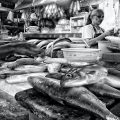Sweet potato (Ipomoea batatas) locally known as kamote, is an important food crop. In some areas of the Philippines, it is a staple particularly among marginalized families in provinces, as they are easy to cultivate and relatively cost less than a kilo of rice.
One of the problems facing the aquaculture industry today is the high cost of fish feed. Nutritionists all over the world are constantly searching for the dietary protein sources of fish to maximize growth and increase production within the shortest possible time and at lowest cost.
The health properties of this rootcrop have been proven beneficial to humans. But do you know that aside from its healthful benefits as human food, it is also being considered an important feed source for the aquaculture industry?
To assess further the potential of the crop, the Tarlac College of Agriculture (TCA) proposed a project titled “Technology Commercialization of Protein-Enriched Sweetpotato as Feed for Aquaculture.” Funded under the National Technology Commercialization Program (NTCP) of the Bureau of Agricultural Research (BAR), the project aimed to commercialize and provide fishpond operators/ owners with affordable and high quality feed formulation for aquaculture specifically in bangus, crabs and prawns. The program leader, Dr. Rodolfo Domo-os is joined in by Dr. Ma. Teresa S.J. Valdez and Dr. Manuelo Agsaoay in this research endeavor with the fishpond operators in Central Luzon and neighboring provinces as collaborators.
Based on the studies conducted by TCA, the protein-enriched sweet potato was done through fermentation which paved the way for the production of inexpensive, high valued aquafeeds. The use of microbial fermentation to produce high protein feed is becoming increasingly important as a means of backstopping the high cost and seasonal availability of conventional feed ingredients. The TCA researchers reported as much as 17-fold increase in the protein content of sweet potato pulp after enrichment by fermentation was achieved.
Sweet potato chips were ground and fermented following the procedures employed in protein enrichment pulp. A standard nutrient solution with some modifications was prepared.
The protein-rich feed was harvested after two weeks of fermentation afterwhich it was sun-dried to remove the odorous metabolites. After drying, the fermented protein-enrished sweet potato (PESP) can remain fresh up to two years without adding anti-oxidants. The project has produced approximately 16.8 tons of the PESP to supply the requirements of the technology showcase for bangus, tilapia, crabs and prawns.
The technology showcased was conducted with pure feeding of PESP to bangus, tilapia, crabs and prawns. It was compared with the fishpond operators’ practices. All feeding trials in commercial ponds were done for the entire grow-out period until the bangus, tilapia, crabs, and prawns were ready for harvesting.
The project was carried out in cooperation with the identified fishpond operators in Malolos, Bulacan; Balanga, Bataan; Dagupan, Pangasinan; and Iba, Zambales, through participatory feeding trials.
The PESP is considered as a breakthrough in aquafeed Industry. The technology is protected by a trademark for a period of 50 years. TCA will establish a feedmill and engage into the mass production and marketing of the product to better serve fishpond operators in Pangasinan, Bataan, Zambales, and Bulacan. The project also hopes to commercialize its operation involving private investors to put-up their capital shares in this venture.
According to Dr. Agsaoay, the cost of production is reasonable and can be mass produced in a village level through technology transfer agreement. The cost to produce a kilo of PESP is Php12.25 or Php 612.50 for every 50-kilo bag.
With this technology, fsherfolk can now realize higher profitability compared with commercial feed utilization. The cost and return analysis comparing PESP from that of commercial feed is comparable. Sustainability in the distribution of the product and sale of the product can be sustained; hence the product is readily available in Tarlac, sweet potato being its flagship crop. Agsaoay assured no competition as to tuber utilization between aquaculture and human consumption.
Feedback from fishpond operators and the fishing communities showed positive response. Big-scale fishpond owners have appreciated the effects and potentials of the feeds as a viable substitute to commercial ones.
At present, a team is in the process of disseminating the studies and technology to neighboring fishpond owners and other stakeholders in the region. ### (Patrick Raymund A. Lesaca)
———-
For more information, please contact:
Dr. Manuelo Agsaoay
Tarlac College of Agriculture (TCA)
Camiling, Tarlac
Mobile: 0918424288
Email: manueloagsaoay@yahoo.com
Source: bar.gov.ph






